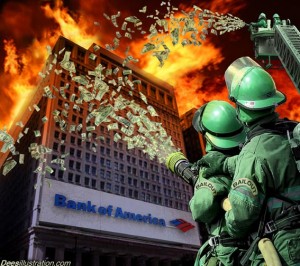 |
| Dees Illustration |
USA Watchdog
If there is one central theme to the ongoing financial crisis we face, it is an insolvent banking system. It is so bad that the accounting rules were changed (after the financial meltdown in 2008) to allow banks to value assets on their books at whatever they think they will fetch far into the future. So, the billions of dollars of underwater mortgage-backed securities and real estate sitting on the balance sheet is held at imaginary values to make many banks look solvent when, in fact, they are not. This is opposite of the way the IRS values assets. The price of something is based on what the asset is worth today. This is called mark to market accounting.
If any of the banks (especially the big banks) want to prove me wrong on this point, then they can simply value all their assets for what they can get for them today and the argument is over—fat chance! I never see this subject ever brought up when the president of a big bank is interviewed. I’ll bet you Jamie Dimon of JPMorgan would really squirm if he was asked what his bank would be worth if all the assets on the balance sheet were valued at today’s price.
In January of 2009, I wrote a piece called “Default Option.” I had the crazy idea that the big banks should be taken into receivership. Yes, shareholders and bond holders would have been wiped out. Tough—that’s investing. The only people you would have to protect are the depositors and, at the time, it would have cost $6 trillion. I said, “Letting those banks take the hit for their ill-advised, reckless investments based on greed will do many things. Here are just a few. Letting the reckless banks fail will limit taxpayer exposure, preserve our capital and our credit rating as a country. Bank failure will wash bad debt out of the system once and for all and protect the dollar from free fall. Finally, I think in the end it will be cheaper and more effective than what has and will be done in the future to “fix” the credit crisis.” (Click here to read the original Default Option post.)
Fast forward to today, and we see the dollar is falling, gold is spiking and the credit rating of the U.S. has been cut. My plan was downright miserly when you consider that the Fed (according to a recent GAO report) spent $16 trillion bailing out the world, with $5 trillion going to foreign banks alone. If you really want jobs in this country, you need capital formation not–debt formation. Capital invests in productive assets, and productive assets create real jobs! We still have a crippled banking system despite spending trillions of dollars, and there are still no jobs!
Read Full Article
No comments:
Post a Comment